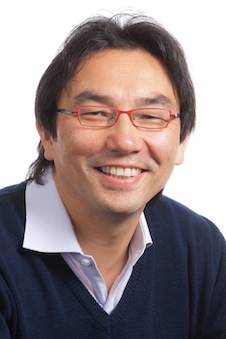
Senior Lecturer Japanese Programme BS (Kwansei Gakuin, Japan)
MA, PhD (University of Southern California)
Office Arts 3S2
Tel +64 3 479 8442
Email j-r.hayashishita@otago.ac.nz
Teaching
- JAPA 331 Advanced Japanese 1
- JAPA 332 Advanced Japanese 2
- JAPA 334 Advanced Japanese 3
- JAPA 351 The Structure of the Japanese Language
Specialisation
- linguistic theory, including the speaker's lexicon, syntax, phonology, semantics
- the Japanese language
Research
My main research interests lie in natural language phenomena in general and the Japanese language in particular. I am developing a comprehensive linguistic theory to define the contribution of syntax (i.e. the computational system to build sentences) to sentence meaning and sound. To that end, I have so far investigated the organization of the speaker's mental lexicon, grammatical constructions such as scrambling, comparatives and passives, and grammatical phenomena such as quantifier scope, anaphoric relations, ellipsis and focus.
 I am the originator, co-founder and leader of the Don動詞どん project, a study of the Japanese lexicon (see www.dondoushidon.org). Our research team, 25 strong in February 2022, is creating a groundbreaking Japanese verbs database.
I am the originator, co-founder and leader of the Don動詞どん project, a study of the Japanese lexicon (see www.dondoushidon.org). Our research team, 25 strong in February 2022, is creating a groundbreaking Japanese verbs database.
My academic mission
First, I aspire to develop a comprehensive linguistic theory, especially to describe Japanese language phenomena adequately and introduce fascinating phenomena of the Japanese language into the field of linguistics. In my view, the theories that currently exist in the field are not adequate, mainly because they were developed with English-type languages in mind, and consequently, many Japanese language phenomena are not properly understood.
Second, I wish to contribute to Japanese language education by capitalizing on my own linguistics research. To this end, with my project team, I am currently compiling Japanese Verbs Reference Book (basic verbs), to be published by Sanseidō, one of the foremost dictionary publishers in Japan. Hayashishita, Tanaka & Ueyama explain the entry organisation of the dictionary in their 2020 article: "A linguistically-informed way of introducing Japanese verbs to second language learners," Journal of Japanese Linguistics, De Gruyter Mouton.
My teaching at Otago and beyond
My teaching at Otago is aligned with my academic mission. I usually teach JAPA 351 "The Structure of the Japanese Language," as well as advanced-level Japanese language acquisition courses.
In JAPA351, I equip students with theoretical tools so that they can analyse the Japanese language. We engage in lively theoretical and empirical discussion, and read some of the classic papers which have shaped my view of Japanese grammar. (This is a demanding course, but students normally like it by the end!)
Regarding the advanced-language acquisition courses, I believe that as the Japanese language is vastly different from English, students need not only to be exposed to Japanese language communication, but also to be able to analyse the language to some extent. I use my research findings to develop their analytical skills.
I was concerned that the standard Japanese curriculum did little to emphasize the importance of analysing the Japanese language and offered so few guidelines, so I resolved to do something about this situation. Motivated by this thought, I have been collaborating with Future Learning Solutions (FLS), formally called International Languages, Exchanges and Pathways (ILEP) in recent years; I have been touring New Zealand and giving workshops on Japanese grammar.
Supervision
I am interested in supervising students who would like to research and describe natural language phenomena. I am also open to supervising research on language use, such as translation and role-languages.
If you have a thought about writing an Honours thesis with me, please talk to me as early as possible (even in your first year), study the Japanese language hard, and take JAPA 351 "The Structure of the Japanese Language", whose prerequisites are LING 111 and JAPA 231. My past Honours students are:
- 2012 Michael Belton, "An Investigation into the Viability of Semantic Theories for Natural Language: A Case Study of Nominal Expressions in Japanese"
- 2013 Alexandra McIntosh, "Japanese Verb Representation in the Speaker's Lexicon"
- 2014 Lisa Thomson, "Are Role-Languages used to preserve the original context or add something new in the translation process?: A case study from the Japanese version of a children's storybook originally in English"
If you are a prospective Masters or PhD student, please write to me about your research topic.
Publications
Hayashishita, J.-R., Tanaka, D., & Ueyama, A. (2020). A linguistically-informed way of introducing Japanese verbs to second language learners. Journal of Japanese Linguistics, 36(1), 29-72. doi: 10.1515/jjl-2019-2017 Journal - Research Article
Ueyama, A., & Hayashishita, J.-R. (2020). Sentence structure and quantifier scope in Japanese: A retrospective and reanalysis. In W. M. Jacobsen & Y. Takubo (Eds.), Handbook of Japanese semantics and pragmatics. (pp. 267-308). Berlin, Germany: De Gruyter Mouton. doi: 10.1515/9781614512073-005 Chapter in Book - Research
Hayashishita, J.-R. (2017). Reconfirming izyoo(ni)- and gurai-comparatives as comparisons of deviation. Journal of East Asian Linguistics, 26(2), 163-187. doi: 10.1007/s10831-016-9152-7 Journal - Research Article
Hayashishita, J.-R. (2013). On the nature of inverse scope readings. Gengo Kenkyu, 143, 29-68. Journal - Research Article
Hayashishita, J.-R., & Bekki, D. (2013). On the semantic relation between nominal and quantity expressions in Japanese. In Y. Motomure, A. Butler & D. Bekki (Eds.), New frontiers in artificial intelligence: JSAI-isAI 2012 Workshops, revised selected papers: Lecture notes in artificial intelligence (Vol. 7856). (pp. 41-52). Heidelberg, Germany: Springer. doi: 10.1007/978-3-642-39931-2_4 Chapter in Book - Research